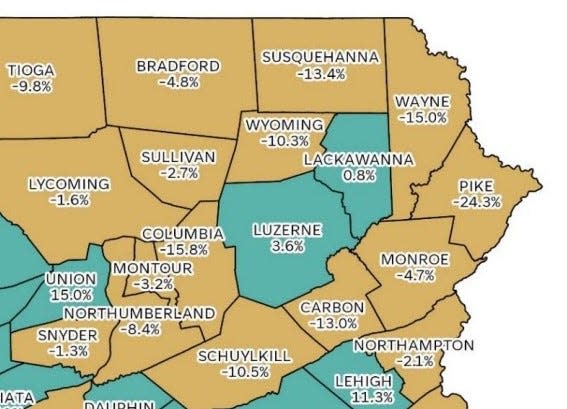Pike County facing sharpest population decline of all Pa. counties
This is our first look at the projected 2050 population of the Poconos. The Pocono Record and Tri-County Independent will continue to explore what this means for health care, education, employment and more in this region. Got questions? Email newsroom@poconorecord.com or editor@tricountyindependent.com.
Pike County is projected to lose nearly a quarter of its population by 2050, the sharpest drop for any county in Pennsylvania, according to projections from the Center for Rural Pennsylvania.
Carbon, Monroe and Wayne counties are also expected to see declines.
Most of Pennsylvania’s growth in the next three decades is expected to occur in Philadelphia and other southeastern counties. In northeastern Pennsylvania, only Lackawanna and Luzerne counties are projected to grow, by 0.8% and 3.6%, respectively.
As the overall population decreases, the number of older adults will rise, and the number of school-age children will shrink.
“This will likely mean fewer individuals in the workforce, greater need for geriatric care and a host of other policy implications,” said Kyle Kopko, executive director of the center, which is a bipartisan legislative agency.

Here’s a look at the projections for the Pocono region.
Carbon County in 2050
Carbon County’s population is projected to decline by 13%, from an estimated 64,744 in 2020 to 56,315 in 2050.
The 65+ population is projected to grow from 14,120 (21.8% of the population) to 16,237 (28.8%).
The school-age population will decrease. Projections are provided for five-year cohorts, including ages 5 to 9, 10 to 14 and 15 to 19. Those groups were estimated to total 10,624 in 2020 and 8,658 in 2050, an 18.5% drop.
Monroe County in 2050
Monroe County faces a less dramatic decrease of 4.7%. A slight increase is projected — 168,316 in 2020 to 169,715 in 2030 — before the population declines to 160,476 in 2050.
The 65+ population is projected to increase from 30,638 to 41,154, growing from 18.2% to 25.6% of the total population.
The 5-to-19 population is projected to drop 20.9% from 30,271 in 2020 to 23,946 in 2050.
Pike County in 2050
Pike was the only county in the Poconos to record a population increase between the 2010 and 2020 censuses. But it faces the steepest drop by 2050, with the population projected to decline 24.3% from 58,560 to 44,313.
The 65+ population is projected increase slightly as a raw number – from 13,789 to 14,248 – and more significantly as a share of the population – 23.5% to 32.2%
In 2020, there were an estimated 9,122 people ages 5 to 19. That’s expected to drop by 36.9% to 5,758 in 2050.
Wayne County in 2050
Wayne County, too, faces one of the sharpest decreases in Pennsylvania, with a projected loss of 15% of the population by 2050 — 51,151 to 43,489.
Unlike in the other three counties, the total number of people age 65 and over is not projected to increase. A slight decrease — 12,657 to 11,977 — is expected, as this cohort’s total share of the population rises from 24.7% to 27.5%.
Those ages 5 to 19 are projected to decrease 18% from 7,374 to 6,050.
The draft of Wayne County’s comprehensive plan update asserts that the Pennsylvania State Data Center has “never adequately considered migration from New York and New Jersey to Wayne County” and so the projected decline “may well be too pessimistic.”
The projections use migration data from the Census Bureau’s American Community Survey, said Kopko and Jennifer Shultz, director of the Pennsylvania State Data Center.
Kathryne Rubright is the managing editor of the Pocono Record and the Tri-County Independent. Reach her at krubright@gannett.com.
This article originally appeared on Pocono Record: Poconos projected to have older, smaller population by 2050
